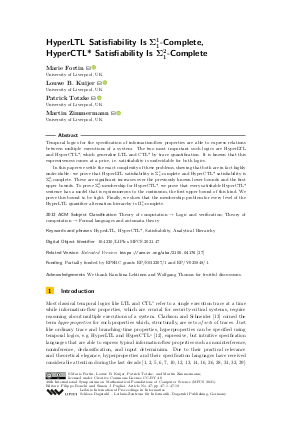@InProceedings{fortin_et_al:LIPIcs.MFCS.2021.47,
author = {Fortin, Marie and Kuijer, Louwe B. and Totzke, Patrick and Zimmermann, Martin},
title = {{HyperLTL Satisfiability Is \Sigma₁¹-Complete, HyperCTL* Satisfiability Is \Sigma₁²-Complete}},
booktitle = {46th International Symposium on Mathematical Foundations of Computer Science (MFCS 2021)},
pages = {47:1--47:19},
series = {Leibniz International Proceedings in Informatics (LIPIcs)},
ISBN = {978-3-95977-201-3},
ISSN = {1868-8969},
year = {2021},
volume = {202},
editor = {Bonchi, Filippo and Puglisi, Simon J.},
publisher = {Schloss Dagstuhl -- Leibniz-Zentrum f{\"u}r Informatik},
address = {Dagstuhl, Germany},
URL = {https://drops.dagstuhl.de/entities/document/10.4230/LIPIcs.MFCS.2021.47},
URN = {urn:nbn:de:0030-drops-144870},
doi = {10.4230/LIPIcs.MFCS.2021.47},
annote = {Keywords: HyperLTL, HyperCTL*, Satisfiability, Analytical Hierarchy}
}

 Creative Commons Attribution 4.0 International license
Creative Commons Attribution 4.0 International license

